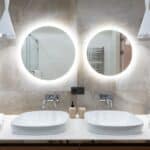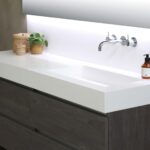This post may contain affiliate links. If you use these links to buy something we may earn a small commission. Thanks.
Brushed nickel faucets are a beautiful choice for your bathroom or kitchen, but they can be hard to keep clean.
This article will show you how to clean brushed nickel faucets and fixtures in 6 simple steps using only the items from around the house. No special products are required!
If your brushed nickel faucet is broken and you’re looking for a new faucet, be sure to check out our full comparison of the best bathroom faucets and best kitchen faucets.
How to Clean Brushed Nickel Faucets and Fixtures in 6 Steps
Here is our 6 step guide for cleaning brushed nickel faucets and fixtures.
1. Gather your Cleaning Supplies
As with cleaning anything, you’ll need the right supplies to get the job done well. It is essential that you gather the items you will need before starting so they are close at hand and won’t become an inconvenience or frustration as you work. Here’s what to gather:
- 2 cleaning cloths
- Vinegar
- Baking soda
- Mild dish soap
- Non-abrasive cleaner
- Spray bottle
- Toothbrush
- Dryer sheet
As a precaution, make sure you stay away from cleaners with alcohol or ammonia and avoid using bleach or any corrosive cleaners. These acidic cleaners will cause dark spots on your brushed nickel if you leave them on it for an extended period of time. This is key to keep brushed nickel faucets from spotting.
2. Use Warm Water, Not Cold
Warm water is the key to cleaning your brushed nickel fixtures without damaging them.
Coldwater causes minerals in the water to harden and leave a white, chalky residue all over your fixtures. This not only makes them look dirty, but it can also damage the finish of those pricey fixtures you love.
On the other hand, warm water allows the minerals to dissolve and be easily wiped away. Warm water also helps break up tough stains that colder water just can’t handle.
3. Choose an Appropriate Cleaning Solution
To start, pour a few drops of mild dish soap into a spray bottle and fill it with warm water. Now, spray this solution on a soft cleaning cloth and wipe down the brushed nickel fixtures.
Next, it’s time to figure out which cleaning solution will work best for you: vinegar, baking soda, or another non-abrasive cleaner.
Diluted vinegar (mix half white vinegar and half water) is the safest, most common cleaning solution for brushed nickel bathroom fixtures. If you see that the marks are still there after using mild dish soap, start with vinegar.
The acetic acid in vinegar dissolves mineral deposits and other residues that water leaves behind. Pour vinegar solution directly onto the fixture and leave it there for about 2 to 5 minutes.
If you notice that some areas aren’t responding to vinegar, prepare a solution of one tablespoon of baking soda with 1/4 cup of warm water.
Baking soda is a magnificent multi-purpose cleaning tool that works well on most surfaces. It provides gentle, natural bleaching power and can even help prevent water spots from forming in the future.
Apply the baking soda solution directly onto the nickel fixture using a microfiber cloth. Let it sit there for about 2 to 3 minutes.
4. Gently and Thoroughly Scrub your Fixture
With your cleaning solution in place, it’s time to use the soft-bristled toothbrush.
Start by scrubbing small areas, then move across the entire brushed nickel fixture until you have finished cleaning everything. Make sure that you get into every nook and cranny, so there aren’t any smudges left behind.
Avoid using any kind of harsh scrubbing tools as they’ll damage your nickel fixtures. Remember, brushed nickel fixtures are more delicate than other bathroom fixture materials, so you need to ensure gentle cleaning.
If you notice layers of soap scum in certain areas that don’t go away after using a toothbrush, you can scrub those areas with dryer sheets.
Dryer sheets are great at getting rid of soap scum. Scrub gently using small, circular motions or hold dryer sheet with both hands and move it from side to side, removing soap scum.
5. Rinse the Fixture Off
Using a damp rag or microfiber cloth, wipe away any leftover cleaning solution once you have scrubbed everything thoroughly. If possible, detach your shower arms and spray the tub faucet for complete cleaning.
Make sure to wipe down each fixture and remove all of the vinegar/soap solutions.
The maximum time to leave the vinegar on a brushed nickel fixture is 30 minutes. Leaving vinegar for more than 30 minutes on your brushed nickel fixtures can tarnish it.
6. Fully Dry the Fixtures
Brushed nickel is a matte surface that does not need to be waxed, and you don’t need to shine the surface. Just wipe dry to remove oil or residue stains.
If you want the finish to look brand new, use another dry, separate cloth and buff all the brushed nickel fixtures. Finish the cleaning process by wiping off the smudges and fingerprints you may have accidentally created.
Once you’re done, allow them to dry for at least one or two hours. This drying time can be shortened by using a blow-dryer to speed up the process.
Frequently Asked Questions About Cleaning Brushed Nickel Faucets and Fixtures
Straight vinegar can damage brushed nickel as it contains acid. However, using diluted vinegar (1:1 ratio) to clean your brushed nickel bathroom fixtures is completely safe and will not cause any damage.
As often as you use them! Brushed nickel bathroom fixtures need cleaning once a week or after every few uses. The best way to determine if they need a good scrubbing is by looking at the watermarks and wiping them down with a damp cloth.
No, you can’t. CLR Bathroom & Kitchen is suitable for chrome or stainless steel faucets but not for other materials, including brushed nickels.
Stainless steel cleaners contain abrasive chemicals such as alcohol or ammonia. You should never use such abrasive chemicals to clean brushed nickel fixtures as they may affect the finish.
Final Words
We hope that you have found this article helpful and that it has answered a few of your questions about how to clean brushed nickel faucets and other fixtures. As long as you ensure not to use any harsh cleaning materials on brushed nickel, you won’t need to worry.
Brushed nickel is one of the most popular bathroom faucet finishes because of it’s classy look and how easy they are to keep clean. If you maintain them well, they’ll last forever!
If you also have satin nickel, take a look at our satin nickel vs brushed nickel finish comparison.

